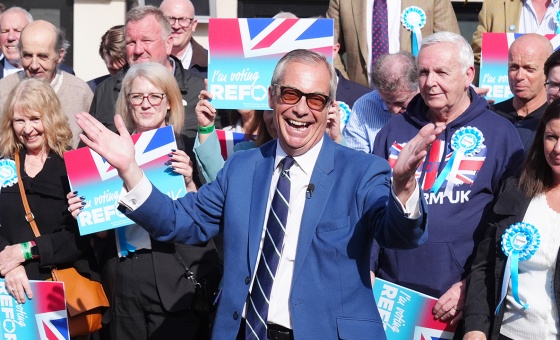This is the last article you can read this month
You can read more article this month
You can read more articles this month
Sorry your limit is up for this month
Reset on:
Please help support the Morning Star by subscribing here
CLASSIFIED Downing Street files on Margaret Thatcher’s meetings with the Union of Democratic Mineworkers (UDM) offer a fascinating insight into her government’s industrial relations strategy.
The revelation that at least three meetings took place will not surprise many who witnessed the Tories’ war with the miners. But some of the details remain startling.
As well as showing Thatcher’s personal investment in paying back strikebreaking miners for helping to end the 1984-85 strike, the documents expose how the PM’s strategy affected her relationship with cabinet colleagues.
The UDM was born at the tail end of the strike in 1985, when the Nottinghamshire NUM voted to break away from the National Union of Mineworkers. The Nottinghamshire section had defied the national call for industrial action and the county was the scene of some of the most bitter clashes between pickets and strikebreakers.
The UDM’s founding president Roy Lynk makes clear in a letter to Thatcher that the union felt a strong affinity with the Tory government. “In 1984 fate threw us together, and I have always comforted myself with the knowledge that the UDM has a friend in the Prime Minister,” he writes.
But in the years after the strike, the UDM struggled to retain its mojo. Some members drifted back to the NUM, and the government’s managed decline of the coal industry could not be escaped. The UDM found itself pushing for wage claims a cost-cutting government would not accommodate.
Thatcher, however, was determined to inform the strikebreakers that they would be rewarded for picking the government’s side.
The first meeting detailed in these files — newly released to the National Archives — took place in 1986. Minutes report that Thatcher thanked Lynk and his colleague George Hunter “for all they had done during the miners’ strike, not just for their contribution to the end of the strike but also for the way they had helped to uphold democracy and freedom in this country.”
And it appears Thatcher was unwilling to delegate negotiations with the UDM in the normal fashion. So much so that energy secretary Cecil Parkinson, one of Thatcher’s closest allies, became concerned.
In a 1988 memo, Thatcher’s private secretary Paul Gray communicates that Parkinson wanted the PM to turn down Lynk’s request for a meeting. “Mr Parkinson is also disappointed that the UDM has not attempted to build a relationship with him, and so would prefer to take any meeting with Mr Lynk himself,” Gray writes.
But in a handwritten note back to Gray at the foot of the document, Thatcher makes it clear that the biggest compromise she is prepared to make is for her and Parkinson to meet the UDM together. “We have to keep the UDM satisfied,” she writes. “We (and the country) owe a lot to their members. MT.”
Though the union had cut ties with the NUM and was disowned by the rest of the labour movement, the documents reveal that Thatcher’s government used the UDM as a means to gain intelligence and strategy tips in its dealings with more hostile organisations. In 1986 Lynk reported that “the UDM was now very close to toppling Arthur Scargill.” In later communications, the breakaway union contends that Scargill’s re-election as NUM president is inevitable.
But though hopes of removing Scargill at the pithead ballot were exhausted, the government’s pit closures strategy could also be powerful in rebalancing the membership numbers of the two unions.
Ahead of the 1988 meeting, Mrs Thatcher is briefed to stress to Mr Lynk that British Coal (formerly the National Coal Board) has “leant over backwards” to continue coal production at closure-threatened pits “with a UDM majority.”
A Downing Street briefing from 1989 — when the third meeting with Lynk took place — begins: “Helping the UDM survive and, if possible, thrive is essential. Not only do we still have reason to thank them for their efforts during the miners’ strike but also we must not allow the coal industry to return to the hands of the NUM.”
Thatcher’s government further sought to use the strikebreakers’ union to undermine the monopoly of the National Association of Colliery Overmen, Deputies and Shotfirers (Nacods).
In 1988 Nacods, which represented safety-critical grades without which mines could not operate, was in dispute with the government over a wage claim.
In a memo to Thatcher, Parkinson says British Coal “are anxious to do everything they can to strengthen the UDM’s long-term position” among grades traditionally represented by Nacods.
“In particular, they intend to give UDM members the training required to become deputies; and to lay down that in UDM majority pits only members of the UDM deputies branch, when it had been formed, would be accepted as deputies,” he writes.
“[British Coal] do not intend to make these intentions publicly known, at least at this stage, since they would seriously complicate the situation with Nacods. However, in the longer term they will help ensure that the UDM continues to offer substantial advantages to its members.”
By the early ’90s, pit closures were accelerating to the point that the government could no longer convince its erstwhile mining allies that they were being shielded.
Facing a backlash from the UDM ranks, Lynk jumped before he was pushed in 1992. Later that year, he staged a week-long sit in at the Silverhill pit, having been “shattered by the government’s callous pit closure plan” and “desperately hurt by the knives in the back from the Tories and British Coal,” according to the Nottingham Evening Post.
His successor Neil Greatrex was jailed for four years in 2012 for stealing £150,000 from a fund intended to help sick miners.
For all the advantages the UDM clawed at the time from breaking the strike, deep mining is now a thing of the past in Britain. As the closing titles say in Stanley Kubrick’s film Barry Lyndon, they are all equal now.
Or perhaps not. Chris Kitchen, the current NUM leader, says there are echoes of Thatcher’s approach to the UDM in how the government handled the closures of the last two pits.
If employers do not properly consult when laying off more than 20 staff, trade unions can apply for a “protective award” for workers on top of their redundancy pay.
The UDM made such a claim after the closure of the last pit where it had a majority of the workforce — Thoresby in Nottinghamshire. Kitchen says the secretary of state, acting alongside administrators PricewaterhouseCoopers, withdrew its defence against paying out such an award.
“But they’re defending vigorously an identical claim for the NUM-majority Kellingley colliery,” he says.
“The relationship with the UDM appears to have continued all the way to 2015.”
- Conrad Landid is Morning Star industrial reporter.






